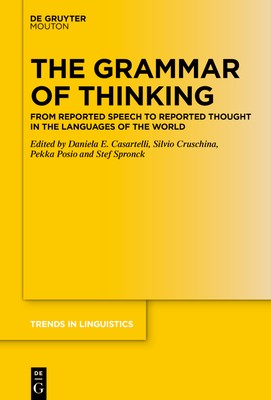
- We will send in 10–14 business days.
- Publisher: de Gruyter Mouton
- ISBN-10: 3112215044
- ISBN-13: 9783112215043
- Format: 15.6 x 23.4 x 1.7 cm, minkšti viršeliai
- Language: English
- SAVE -10% with code: EXTRA
The Grammar of Thinking (e-book) (used book) | bookbook.eu
Reviews
Description
Sentence (1) represents the phenomenon of reported thought, (2) that of reported speech:
(1) Sasha thought: "This is fine" or Sasha thought that this would be fine
(2) Sasha said: "This is fine" or Sasha said that this would be fine
While sentences as in (1) have often been discussed in the context of those in (2) the former have rarely received specific attention. This has meant that much of the semantic and structural complexity, cross-linguistic variation, as well as the precise relation between (1) and (2) and related phenomena have remained unstudied.
Addressing this gap, this volume represents the first collection of studies specifically dedicated to reported thought. It introduces a wide variety of cross-linguistic examples of the phenomenon and brings together authors from linguistic typology, corpus and interactional linguistics, and formal and functional theories of syntax to shed light on how talking about thoughts can become grammar in the languages of the world.
The book should be of interest to linguists, philosophers of language, linguistic anthropologists and communication specialists seeking to understand topics at the boundary of stylistics and morphosyntax, as well as the grammar of epistemicity.
EXTRA 10 % discount with code: EXTRA
The promotion ends in 23d.23:00:59
The discount code is valid when purchasing from 10 €. Discounts do not stack.
- Publisher: de Gruyter Mouton
- ISBN-10: 3112215044
- ISBN-13: 9783112215043
- Format: 15.6 x 23.4 x 1.7 cm, minkšti viršeliai
- Language: English English
Sentence (1) represents the phenomenon of reported thought, (2) that of reported speech:
(1) Sasha thought: "This is fine" or Sasha thought that this would be fine
(2) Sasha said: "This is fine" or Sasha said that this would be fine
While sentences as in (1) have often been discussed in the context of those in (2) the former have rarely received specific attention. This has meant that much of the semantic and structural complexity, cross-linguistic variation, as well as the precise relation between (1) and (2) and related phenomena have remained unstudied.
Addressing this gap, this volume represents the first collection of studies specifically dedicated to reported thought. It introduces a wide variety of cross-linguistic examples of the phenomenon and brings together authors from linguistic typology, corpus and interactional linguistics, and formal and functional theories of syntax to shed light on how talking about thoughts can become grammar in the languages of the world.
The book should be of interest to linguists, philosophers of language, linguistic anthropologists and communication specialists seeking to understand topics at the boundary of stylistics and morphosyntax, as well as the grammar of epistemicity.


Reviews